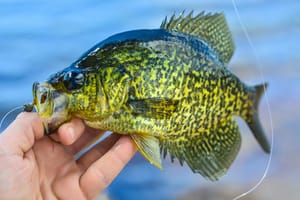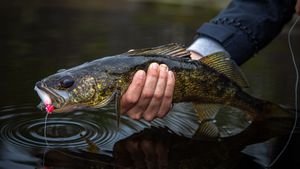Crappie fishing is an art, and like any artist, a crappie angler must choose their palette with care. The right jig color can make all the difference in your fishing success. This guide is designed to help you understand the nuances of selecting the best crappie jig colors to catch crappie consistently.
Key Takeaways:
- Understanding the influence of water clarity and light conditions on jig color selection is crucial for crappie fishing.
- Certain colors like chartreuse, blue ice, and electric chicken are consistently effective under various fishing conditions.
- Experimenting with color combinations and paying attention to the natural forage in your fishing area can significantly improve your catch rate.
The Science Behind Color Selection
When it comes to crappie fishing, the color of your jig can be as important as the bait itself. Crappie lures come in a rainbow of colors, but not all hues are created equal. Light conditions and water clarity play a pivotal role in how crappie perceive color. In clear water, crappie can discern colors more accurately, while in stained or muddy water, brighter and fluorescent colors become more visible.
Matching the Hatch
One of the most effective strategies in selecting jig colors is to "match the hatch." This means choosing a lure color that mimics the crappie's natural forage fish. In waters where baitfish like shad or minnows are prevalent, shades of silver, gray, and white, such as the popular "baby shad" or "monkey milk," can be incredibly effective.
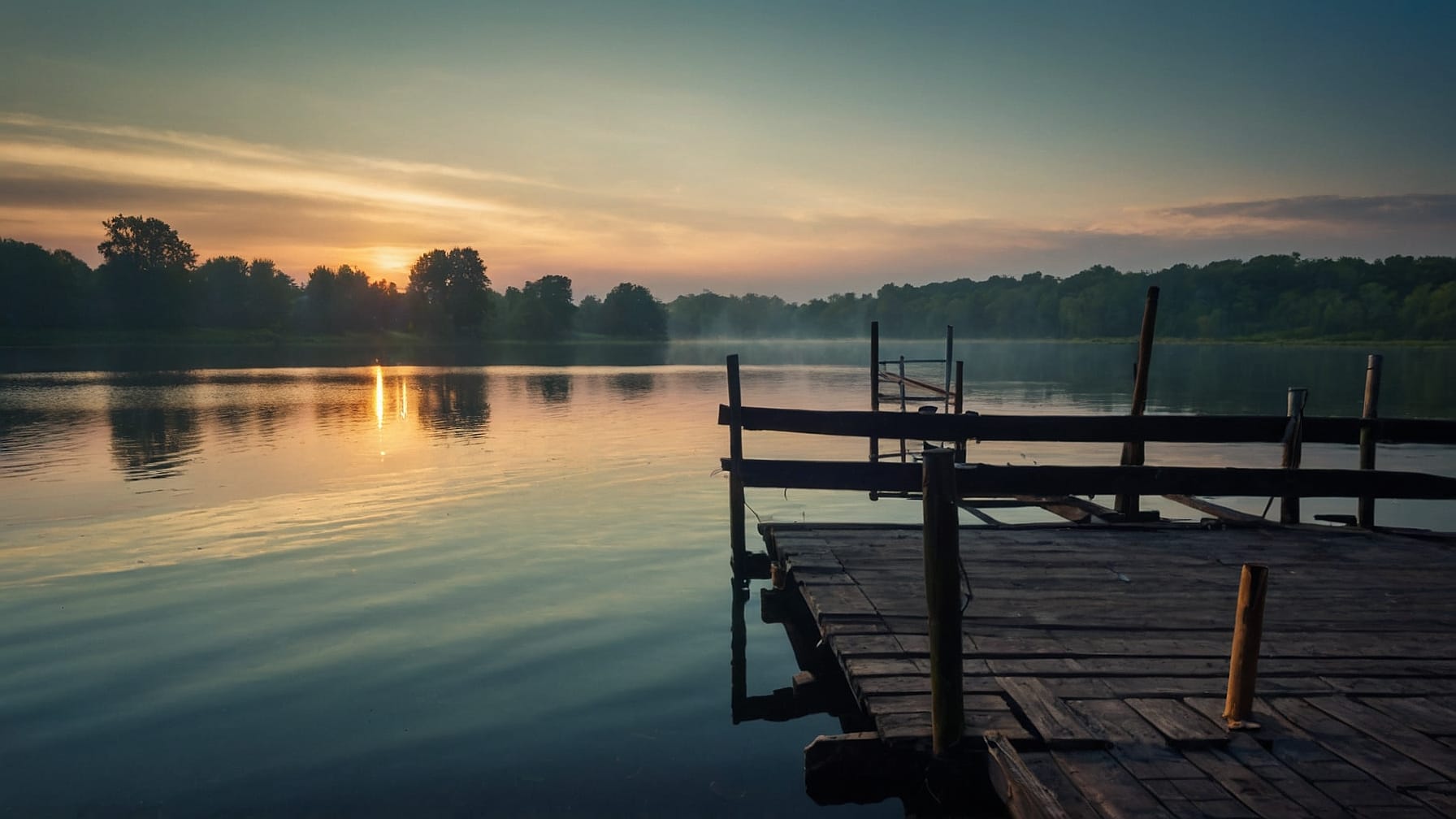
The Impact of Light Conditions
Light conditions can drastically alter the appearance of your jig in the water. On bright, sunny days, crappie lures with metallic flakes or a blue glimmer can reflect light, attracting crappie from a distance. Conversely, on cloudy days or in low light conditions, crappie anglers should opt for lures that stand out against the darker backdrop, such as bright white or chartreuse.
Water Clarity Wonders
Water clarity is another critical factor in choosing any lure color. In clear water, natural and subtle colors are often the best choice, as they closely resemble live bait, enabling crappie anglers to mimic the crappie's natural prey more effectively.
However, in stained or muddy water, where visibility is significantly reduced, bright colors and bold patterns can be more effective in catching crappie's attention. These vivid hues and striking designs stand out in murky conditions, triggering the predatory instincts of crappie and improving your chances of a successful catch.
The Allure of Fluorescent Colors
Fluorescent colors have a special place in the crappie angler's tackle box, offering a unique advantage in various fishing conditions. These bright colors, such as electric chicken or fluorescent orange, can be particularly useful in stained water conditions where visibility is low. They provide a stark contrast against the murky backdrop, making them highly visible and irresistible to crappie searching for a meal.
Moreover, on overcast days or during dawn and dusk when light levels are low, these fluorescent colors can absorb and emit light, creating a glowing effect that can effectively attract crappie from greater distances. This luminescence can be the key to triggering aggressive strikes, turning an otherwise challenging day on the water into a productive fishing session.
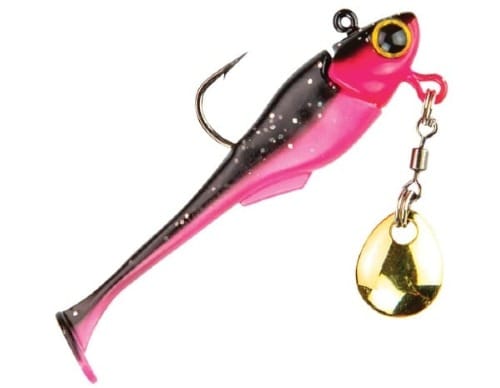
The Versatility of Chartreuse
Few crappie fishermen would dispute the effectiveness of chartreuse in crappie fishing, a testament to its unmatched versatility and appeal under a wide range of conditions. This bright, vibrant color excels in clarity and visibility across various water conditions—from the clearest of lakes to the murkiest of streams—making it a consistent performer on days when other colors might blend into the background.
Whether employed as a solid hue on crappie jigs and lures or integrated into a color combination to add an extra flash of visibility, chartreuse has proven itself to be an indispensable tool in the crappie fisherman's arsenal. Its ability to simulate the natural fluorescence found in some of the crappie's prey makes it particularly effective during dawn and dusk, when bright light penetration is low but fish activity is high.
As such, chartreuse is not just a color choice; it's a strategic decision that can significantly enhance the chances of a successful catch, cementing its status as a must-have for any serious crappie angler.
The Role of Jig Size and Shape
While color is important, it's not the only factor to consider in the quest for a successful crappie catch. The size and shape of the jig also play a crucial role in enticing crappie to bite, with each element tailored to mimic the prey of crappie in different conditions.
Larger eyes, specific body shapes that resemble natural forage, and even the way a jig moves through the water can all significantly influence a crappie's decision to strike. For instance, a slender, minnow-like jig shape is ideal for mimicking small fish, while a broader, more bulbous shape might better replicate a small crustacean, appealing to crappie’s varied dietary preferences.
Moreover, the action imparted by the jig's design—whether it darts erratically or glides smoothly—can make all the difference in triggering the predatory instincts of crappie, especially in waters where they are highly pressured or finicky. These nuances underscore the importance of matching jig size and shape to the specific fishing conditions and crappie behaviors for optimal results.
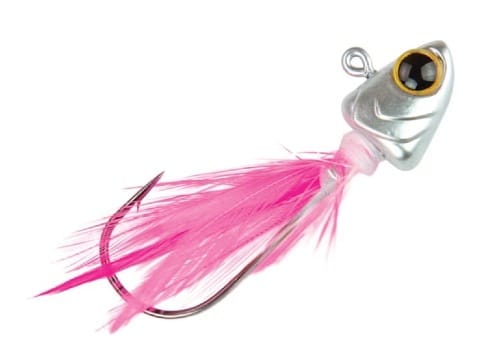
Experimenting with Color Combinations
Sometimes, the best crappie jig color is a combination of colors. Experimenting with two-toned jigs or those with multiple color patterns can be highly effective. For example, a jig with a chartreuse body and a pink tail can offer the best of both worlds, providing visibility and mimicking the subtle hues of natural prey.
Understanding Seasonal Preferences
Crappie preferences can change with the seasons. During the colder months, crappie may respond better to darker colors that absorb more light and appear warmer. In contrast, during the warmer months, lighter and more reflective jig colors can be more appealing to these fish.
The Importance of Personal Experience
While there are general guidelines for selecting the crappie jig color, personal experience is invaluable. Paying attention to what works in your home waters and under specific conditions can help you refine your color choices and become a more successful crappie angler.
Adapting to Changing Conditions
Catching crappie is often about adaptation. As weather conditions change, so too should your jig color selection. Being prepared with a variety of colors and being willing to switch things up can mean the difference between a good day and a great day on the water.
The Power of Presentation
Even the best crappie jig color won't be effective if it's not presented correctly. Techniques like using a loop knot for more natural jig movement or adjusting your retrieval speed can enhance the effectiveness of your chosen jig color. Additionally, the depth at which the jig is fished plays a critical role, as crappie tend to feed at specific depths depending on the water temperature and time of day.
Matching the jig’s presentation to these conditions by varying the depth and incorporating pauses or twitches can significantly increase the chances of eliciting a strike. This strategic approach ensures that the jig not only looks appealing but also behaves in a manner that's irresistible to crappie, making presentation a key element in the art of crappie fishing.
Summary
Selecting the color for you jig is a combination of science, experience, and a bit of intuition. By understanding the effects of light conditions, water clarity, and crappie behavior, anglers can make informed decisions that lead to more successful outings. Remember to experiment with different colors, pay attention to the natural forage, and adapt to the conditions at hand. With these tips in mind, you'll be well on your way to mastering the art of crappie jig color selection. Discover the secrets to landing monster slabs with these 10 essential crappie jigs that will transform you into a fishing pro overnight!
FAQ Section
Does jig color really make a difference when fishing for crappie?
Yes, jig color can significantly impact your success when fishing for crappie. The right color can make your lure more visible and attractive to crappie, especially in relation to the water clarity and light conditions.
What are some of the best crappie jig colors for clear water?
In clear water, natural colors like silver, gray, and light shades that mimic baitfish are typically the best choices. Subtle colors like baby shad, monkey milk, and blue ice can be very effective.
Can I use the same jig color in both stained and clear water?
While some colors like chartreuse can work in various water conditions, it's generally best to adjust your jig colors based on the water clarity. Bright and fluorescent colors tend to perform better in stained or muddy water, while more natural and subtle colors are preferable in clear water.


